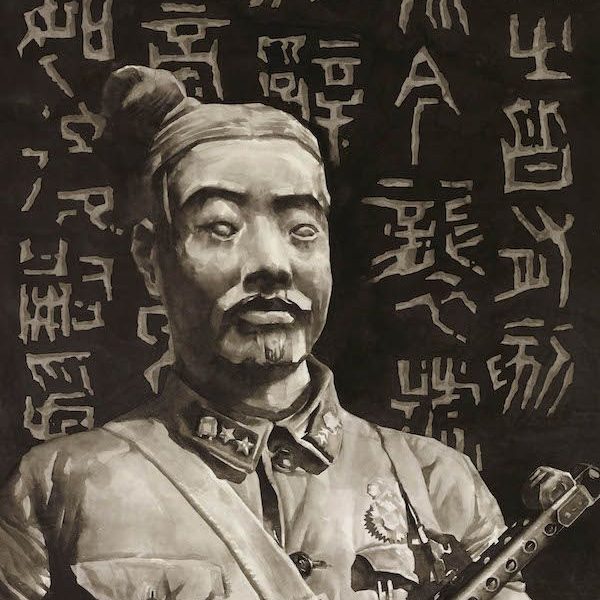
Ashmolean Museum
7 November 2017–15 April 2018
Leading Chinese artist Qu Leilei will show new work in an autumn exhibition in the Ashmolean’s Chinese Paintings Gallery.
Qu Leilei (b.1951) is an internationally renowned artist based in London. He was born in the northeastern province of Heilongjiang and grew up during the political and cultural turbulence of late twentieth-century China. He started his career as a founding member of the ‘Stars Group’, China’s first avant-garde artistic movement (which later included Ai Weiwei). Formed in Beijing in 1979, the group’s members were writers and artists who aimed to encourage individuality and artistic expression under the Communist regime. Qu Leilei left China in 1985, moving to England to study western art. Since then his work has been exhibited in galleries and museums in China, Hong Kong and the UK and is represented in private collections around the world.
Qu Leilei’s innovative contribution to ink art is well-established in his monochrome figural painting. In this genre we can see his distinctive visual language which blends lively brushwork and western technique with sensitivity and virtuosity. A signature work is Danaë (2016), a monumental female nude, the title drawn from the erotic mythologies of western art. Lying upon a magnificent expanse of oriental tapestry, the figure is reminiscent of European Old Masters. In its method of expressing light the painting draws inspiration from Rembrandt’s Danaë; yet its composition is influenced by Klimt’s erotic portrayals of the female figure. The nudity in Qu Leilei’s ink paintings is tranquil and beautiful, an exquisite presentation of the ideal in all its imagined loveliness. As in many of Qu Leilei’s figural paintings, Danaë shows the subject from behind, employing a skillful rendition of light and shadow to convey emotion in lieu of any facial expression. The transparency of the brushwork creates the flawless, porcelain skin – an oriental aesthetic which sets the work apart from western interpretations of the subject.
Other highlights that show Qu Leilei’s mastery with brush and ink include his depictions of hands, one of the most difficult subjects to draw. The hand paintings are powerful images both technically impressive and powerfully emotive. A moving example is Friendship (2012) which shows the hands of Chinese art scholar Michael Sullivan (1916–2013) and Qu Leilei’s wife, Caroline. The expertly rendered gesture of their clasping hands and the monumental composition which fills the picture space convey the warmth and depth of a 30-year friendship.
Unlike many of his contemporaries, Qu Leilei’s particular gift is his ability to unite east and west, tradition and modernity and the significance of his art lies in a complex interplay of aesthetics, immigrant experience and Chinese history. The latter is a subject he has explored since 2010 in the series, ‘A Thousand Years of Empire’. The Soldier(2013) and The Invincible (2015) explore the cultural trauma of institutionalised personality in China through reference to the standardised figures of the Terracotta Army destined to stand guard in the afterlife of the first emperor, Qin Shihuang (259–210 BC).
In other work, Qu Leilei reveals his palpable love of the British pastoral landscape and changeable weather. He has travelled widely around Britain producing ink drawings and sketches that portray a vivid feeling for nature. His abstract British landscape paintings are excellent examples, combining rural tranquility with an unsettled, ever-changing climate. He spends hours walking through the countryside, taking time to observe and experience seasonal changes in nature. He applies expressive, sweeping and calligraphic brushstrokes to give the landscape atmospheric effects and poetic interpretation. The delightful Autumn (2016), painted especially for this exhibition, takes the Radcliffe Camera – one of the iconic buildings of the University of Oxford – as its subject, set against a dark, brooding sky.
The exhibition includes Qu Leilei’s early drawings of the Stars period, calligraphic collages and elaborate figure paintings from 1983 to the present showing the multifaceted and experimental nature of his work. The pieces on display are drawn from the Ashmolean’s own collection and additional works are on loan from the artist.
Dr Yan Liu, Christensen Fellow of Chinese Painting, Ashmolean, says: ‘The idea for a solo exhibition of Qu Leilei’s work followed a visit I made to the artist’s studio in London last year. I saw a selection of astonishing new paintings. It is a privilege to show some of these new works alongside earlier drawings and paintings in the exhibition which charts the dramatic development of this influential artist over the past three decades.’
今年秋天,中國藝術家曲磊磊將在阿什莫林博物館中國繪畫館展出自己的新作。本次展覽囊括了他在“星星時期”的作品和自1983年至今的書法拼貼畫與精美的人物繪畫,全方位展現了他創作的多面性和實驗性。
曲磊磊於1951年在黑龍江出生,在二十世紀晚期中國政治與文化動盪的時期長大。在他藝術生涯的初始,他是中國第一個前衛藝術團體——“星星畫會”的創始人之一。自1985年搬到英格蘭學習西方藝術後,他的作品陸續在中國、香港和英國展出並成為世界各地的私人收藏品。本次展覽中為觀眾帶來的最新作品《達娜厄》、《友誼》、《士兵》、《不可戰勝》和《秋天》不容錯過。







